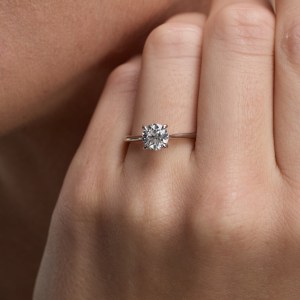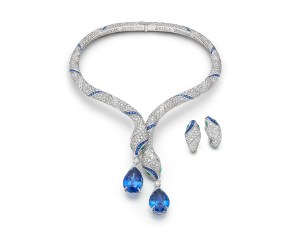
What to Watch: Retailers Go Big on Lab-grown Diamonds
Lab-grown diamonds are poised to have a major year at leading retailers as consumer interest and unique offerings continue to grow across the country.
Large retailers like Walmart, JCPenney, Zales, Kay Jewelers and Pandora, among others, have already made entries into the lab-grown diamond category, and have 2024 growth plans to keep up with demand.
According to a September 2023 report from MVI Marketing, a research and communications company for the watches and jewelry industries, 53 percent of U.S. consumers would choose a lab-grown diamond over a mined option. The report also stated that 70 percent of retailers surveyed said margins for lab-grown diamonds are 20 to 40 percent higher than those of the mined variety.
“We’re experiencing a gigantic demographic shift in the consumer,” said Marty Hurwitz, chief executive officer of MVI Marketing. “Younger consumers not only want to spend less money on anything, but they’re better educated. The better educated the consumer is, the more they’re interested in climate change and any consumer products that talk to sustainability. So, [lab-grown diamonds] are sort of a new discussion related to diamonds instead of mined diamonds — that’s attractive to younger consumers and that’s attractive if you combine [sustainability] with the price drop that they’re able to get.”
The end of 2023 saw a big push from mass market retailers into the lab-grown diamond category. Walmart, which debuted lab-grown diamonds in 2022, introduced a wider collection last fall that included more than 80 styles across fashion jewelry and bridal pieces. This was in response to the retailer seeing a 600 percent year-over-year sales increase in the category.
An engagement ring from Walmart’s lab-grown diamond collection.
Courtesy of Walmart
“It allows our customer to own and buy a larger stone at a much better quality, at a fraction of the price that they could get in mined,” said Michelle Gill, the vice president of jewelry and accessories at Walmart. “So, it really opens up the opportunity to have a real diamond at a quality that they before likely wouldn’t be able to afford or didn’t want to spend.”
While retailers are keen to grow their lab-grown diamond offerings, mined diamonds still comprise the majority of their diamond jewelry offerings. At Walmart, for instance, lab-grown diamonds only make up 30 percent of the retailer’s diamond jewelry styles.
At Walmart, bridal lab-grown diamond styles are leading the overall category. Gill named the retailer’s 1.5-carat engagement ring — the largest diamond in lab or mined at Walmart — as a top seller at $698. Gill stated the size of the ring compares to a price of $5,800 if it were created with mined diamonds.
JCPenney, which was one of the first mass retailers to enter the lab-grown diamonds category in 2018, also made additional efforts last year with a marketing campaign centered on its new collections.
According to the retailer’s head of fine jewelry Pam Mortensen, JCPenney saw an increase of up to 50 percent in sales across lab-grown diamond jewelry categories last year.
“You’ve heard of the four C’s in diamonds — cut, clarity, carat weight and color,” she said. “So, at JCPenney, we’ve added that fifth ‘C,’ which is choice. We feel that by offering the lab-grown diamonds as an alternative to mined diamonds, we can offer our customer a higher quality diamond at a lower retail [price].”
Similarly at JCPenney, bridal styles are leading the category. The retailer has also seen success in its fashion jewelry side, namely with lab-grown diamond stud earrings.
Signet Jewelers also homed in on the lab-grown diamond bridal category with several designer collaborations in the last few months. The jewelry conglomerate debuted collections such as lab-grown diamond bridal collections with Neil Lane and Monique Lhuilllier at Kay Jewelers.
At Pandora, the Copenhagen-based jeweler expanded its lab-grown diamond assortment with three new collections and a star-studded campaign last year with the goal of hitting roughly $140 million in sales by 2026.
“Compared to a specialty jewelry retailer, these mass merchants really talk to a wide variety of consumers and a very large scale of consumers,” Hurwitz said. “So it’s not surprising that now that they have a product, they’re seeing traction. It’s a complete disruption for their jewelry counters right now — so much so that many of them are wanting to exchange their mined diamond inventory for lab-grown inventory.”
Bridal remains a key driver for these mass market retailers; however, many are seeing opportunities to grow their lab-grown diamond fashion jewelry offerings in 2024 as demand continues. At Walmart, for instance, the retailer is seeing growing interest in tennis bracelets, earrings and necklaces.
“There’s going to continue to be an opportunity on the fashion side with lab-grown where customers at all levels will feel a lot more comfortable spending on a lab-grown than really a mined diamond, especially for fashion,” Gill said. “There will always be those customers who want a mined for bridal, although we’re seeing that shift considerably, especially with the younger generation. But I think a great introduction into lab-grown is in fashion, so we’ll continue to see interest grow there.”


